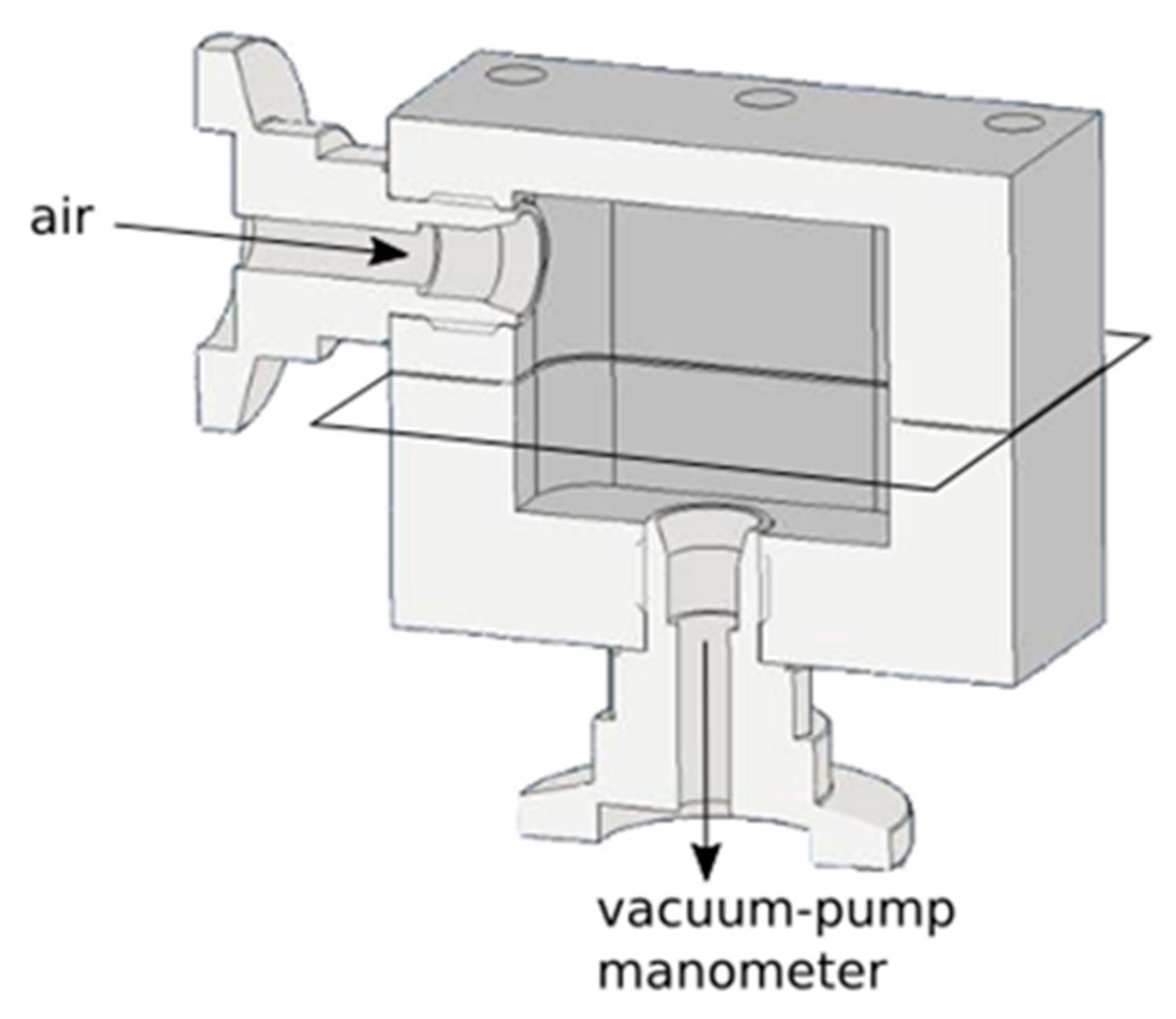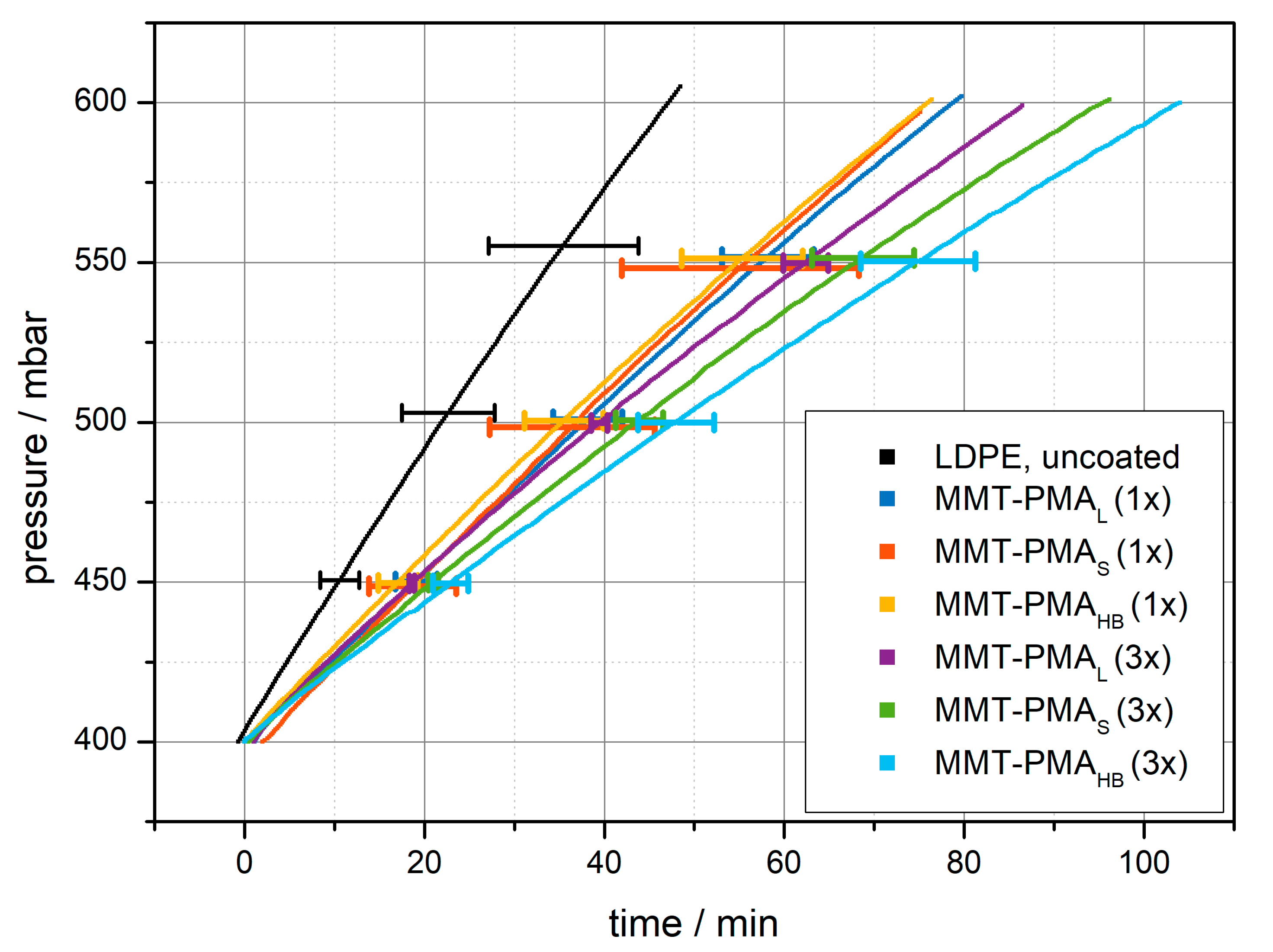Increasing the Gas Barrier Properties of Polyethylene Foils by Coating with Poly(methyl acrylate)-Grafted Montmorillonite Nanosheets
Abstract
:1. Introduction
2. Materials and Methods
2.1. Materials
2.2. Synthesis of Polymer-Grafted MMT Nanosheets
2.3. Coating of LDPE Foils with Polymer Grafted Nanosheets
2.4. Methods
2.4.1. Gas Permeability Measurements
2.4.2. Thermogravimetric Analysis
2.4.3. NMR
3. Results
3.1. Sample Preparation
3.2. Analysis of the Gas Barrier Properties
4. Conclusions
Author Contributions
Funding
Institutional Review Board Statement
Informed Consent Statement
Data Availability Statement
Conflicts of Interest
References
- Anukiruthika, T.; Sethupathy, P.; Wilson, A.; Kashampur, K.; Moses, J.A.; Anandharamakrishnan, C. Multilayer packaging: Advances in preparation techniques and emerging food applications. Compr. Rev. Food Sci. Food Saf. 2020, 19, 1156–1186. [Google Scholar] [CrossRef] [PubMed] [Green Version]
- Ding, F.; Liu, J.; Zeng, S.; Xia, Y.; Wells, K.M.; Nieh, M.-P.; Sun, L. Biomimetic nanocoatings with exceptional mechanical, barrier, and flame-retardant properties from large-scale one-step coassembly. Sci. Adv. 2017, 3, e1701212. [Google Scholar] [CrossRef] [PubMed] [Green Version]
- Schmid, M.; Dallmann, K.; Bugnicourt, E.; Cordoni, D.; Wild, F.; Lazzeri, A.; Noller, K. Properties of whey-protein-coated films and laminates as novel recyclable food packaging materials with excellent barrier properties. Int. J. Polym. Sci. 2012, 2012, 5–7. [Google Scholar] [CrossRef] [Green Version]
- Cinelli, P.; Schmid, M.; Bugnicourt, E.; Wildner, J.; Bazzichi, A.; Anguillesi, I.; Lazzeri, A. Whey protein layer applied on biodegradable packaging film to improve barrier properties while maintaining biodegradability. Polym. Degrad. Stab. 2014, 108, 151–157. [Google Scholar] [CrossRef]
- Topolniak, I.; Gardette, J.L.; Therias, S. Influence of zeolite nanoparticles on photostability of ethylene vinyl alcohol copolymer (EVOH). Polym. Degrad. Stab. 2015, 121, 137–148. [Google Scholar] [CrossRef]
- Wolf, C.; Angellier-Coussy, H.; Gontard, N.; Doghieri, F.; Guillard, V. How the shape of fillers affects the barrier properties of polymer/non-porous particles nanocomposites: A review. J. Memb. Sci. 2018, 556, 393–418. [Google Scholar] [CrossRef]
- Vilarinho, F.; Vaz, M.F.; Silva, A.S. The Use of Montmorillonite (MMT) in Food Nanocomposites: Methods of Incorporation, Characterization of MMT/Polymer Nanocomposites and Main Consequences in the Properties. Recent Pat. Food. Nutr. Agric. 2019, 11, 13–26. [Google Scholar] [CrossRef] [PubMed]
- Majeed, K.; Arjmandi, R.; Hassan, A. Mechanical and oxygen barrier properties of LDPE/MMT/MAPE and LDPE/MMT/EVA nanocomposite films: A comparison study. J. Phys. Sci. 2018, 29, 43–58. [Google Scholar] [CrossRef]
- Xie, L.; Lv, X.Y.; Han, Z.J.; Ci, J.H.; Fang, C.Q.; Ren, P.G. Preparation and Performance of High-Barrier Low Density Polyethylene/Organic Montmorillonite Nanocomposite. Polym.-Plast. Technol. Eng. 2012, 51, 1251–1257. [Google Scholar] [CrossRef]
- Mooninta, S.; Poompradub, S.; Prasassarakich, P. Packaging Film of PP/LDPE/PLA/Clay Composite: Physical, Barrier and Degradable Properties. J. Polym. Environ. 2020, 28, 3116–3128. [Google Scholar] [CrossRef]
- Chen, R.; Wang, C.; Huang, Y.; Le, H. An efficient biomimetic process for fabrication of artificial nacre with ordered-nanostructure. Mater. Sci. Eng. C 2008, 28, 218–222. [Google Scholar] [CrossRef]
- Liang, B.; Zhao, H.; Zhang, Q.; Fan, Y.; Yue, Y.; Yin, P.; Guo, L. Ca 2+ Enhanced Nacre-Inspired Montmorillonite–Alginate Film with Superior Mechanical, Transparent, Fire Retardancy, and Shape Memory Properties. ACS Appl. Mater. Interfaces 2016, 8, 28816–28823. [Google Scholar] [CrossRef] [PubMed]
- Priolo, M.A.; Holder, K.M.; Guin, T.; Grunlan, J.C. Recent advances in gas barrier thin films via layer-by-layer assembly of polymers and platelets. Macromol. Rapid Commun. 2015, 36, 866–879. [Google Scholar] [CrossRef] [PubMed]
- Rauschendorfer, J.E.; Möckelmann, J.; Vana, P. Enhancing the Mechanical Properties of Matrix-Free Poly(Methyl Acrylate)-Grafted Montmorillonite Nanosheets by Introducing Star Polymers and Hydrogen Bonding Moieties. Macromol. Mater. Eng. 2021, 2100054, 1–6. [Google Scholar] [CrossRef]
- Rauschendorfer, J.E.; Thien, K.M.; Denz, M.; Köster, S.; Ehlers, F.; Vana, P. Tuning the Mechanical Properties of Poly(Methyl Acrylate) via Surface-Functionalized Montmorillonite Nanosheets. Macromol. Mater. Eng. 2020, 2000595, 1–9. [Google Scholar] [CrossRef]
- Rossner, C.; Tang, Q.; Glatter, O.; Müller, M.; Vana, P. Uniform Distance Scaling Behavior of Planet-Satellite Nanostructures Made by Star Polymers. Langmuir 2017, 33, 2017–2026. [Google Scholar] [CrossRef] [PubMed]
- Salem, N.; Shipp, D.A. Polymer-layered silicate nanocomposites prepared through in situ reversible addition-fragmentation chain transfer (RAFT) polymerization. Polymer 2005, 46, 8573–8581. [Google Scholar] [CrossRef]
- Scriven, L.E. Physics and Applications of DIP Coating and Spin Coating. MRS Proc. 1988, 121, 717. [Google Scholar] [CrossRef]


| Sample | Number of Coating Cycles | Δt400→600mbar/min |
|---|---|---|
| LDPE | 0 | 38 ± 11 |
| LDPE + MMT-PMAL | 1 | 79 ± 11 |
| LDPE + MMT-PMAS | 1 | 74 ± 16 |
| LDPE + MMT-PMAHB | 1 | 77 ± 8 |
| LDPE + MMT-PMAL | 3 | 86 ± 4 |
| LDPE + MMT-PMAS | 3 | 96 ± 8 |
| LDPE + MMT-PMAHB | 3 | 104 ± 8 |
Publisher’s Note: MDPI stays neutral with regard to jurisdictional claims in published maps and institutional affiliations. |
© 2021 by the authors. Licensee MDPI, Basel, Switzerland. This article is an open access article distributed under the terms and conditions of the Creative Commons Attribution (CC BY) license (https://creativecommons.org/licenses/by/4.0/).
Share and Cite
Rauschendorfer, J.E.; Vana, P. Increasing the Gas Barrier Properties of Polyethylene Foils by Coating with Poly(methyl acrylate)-Grafted Montmorillonite Nanosheets. Polymers 2021, 13, 3228. https://doi.org/10.3390/polym13193228
Rauschendorfer JE, Vana P. Increasing the Gas Barrier Properties of Polyethylene Foils by Coating with Poly(methyl acrylate)-Grafted Montmorillonite Nanosheets. Polymers. 2021; 13(19):3228. https://doi.org/10.3390/polym13193228
Chicago/Turabian StyleRauschendorfer, Judith E., and Philipp Vana. 2021. "Increasing the Gas Barrier Properties of Polyethylene Foils by Coating with Poly(methyl acrylate)-Grafted Montmorillonite Nanosheets" Polymers 13, no. 19: 3228. https://doi.org/10.3390/polym13193228






